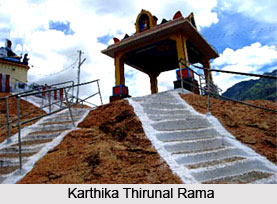 Travancore was a princely state ruled by the Travancore Royal Family. The modern day southern Kerala, the Kanyakumari district, and the southernmost parts of Tamil Nadu comprised ancient Travancore. Padmanabha Swamy was considered as the first ruler of Travancore. In the Sangam Age Travancore was ruled by the Tamil dynasty. Nelkinda was its capital. History of Travancore is replete with many battles, police atrocities and merging of like minded language regions.
Travancore was a princely state ruled by the Travancore Royal Family. The modern day southern Kerala, the Kanyakumari district, and the southernmost parts of Tamil Nadu comprised ancient Travancore. Padmanabha Swamy was considered as the first ruler of Travancore. In the Sangam Age Travancore was ruled by the Tamil dynasty. Nelkinda was its capital. History of Travancore is replete with many battles, police atrocities and merging of like minded language regions.
Early Rulers of Travancore
Travancore was ruled by Kshatriyas belonging to the Samanthan Nair caste. This caste had followed a matrilineal system of inheritance known as Marumakkathayam. The modern Travancore history begins with Marthanda Varma who inherited the Kingdom of Venad. He expanded it into Travancore during his reign in 1729 AD - 1758 AD. Padmanabapuram was the capital before it being shifted of the capital to Thiruvananthapuram.
Rule of Marthanda Verma
Marthanda Varma had expanded his kingdom from Kanyakumari in the South to Kodungallur in the North. He with the help of the British destroyed the power of the feudal land lords. He consequently succeeded in absorbing kingdoms of Cochin including Kayamkulam Attingal, Kollam, Kottayam, Kottarakara, Meenachil, Poonjar, Ambalapuzha and Changanassery. He also defeated the Dutch East India Company. In the battle of Ambalapuzha, he defeated the union of the deposed Kings and the Raja of Cochin. Marthanda Varma introduced titles, such as, Chempaka Raman and Ettarayum Koppum to honour those who had remained faithful to him.
Reign of Dharma Raja
Karthika Thirunal Rama Varma succeeded the throne. He was also known as Dharma Raja. His period is considered as a golden age Travancore`s history. He kept the empire intact and improved and encouraged developments in the society as a whole. Tipu Sultan, the Mysore ruler had attacked Travancore in 1789. Dharma Raja refused to hand over the refugees of Mysore. The Travancore armies withstood the Sultan and were able to defeat them. The Dharma Raja improved trade in the country. During his reign Kalakkad districts and parts of Shencottah were annexed to Arcot.
Reign of Balarama Varma
Balarama Varma ascended the throne after Dharma Raja`s death. He was weaker than his predecessors. The divan started taking control of the kingdom. Velu Thampi emerged as the ruling divan. He played an important role in creating a new treaty with the English East India Company. However, due to differences later on, a war was declared on them. The Company defeated Velu Thampi at Nagercoil and Kollam battles as he did not get full support of the kings. He organised a guerilla struggle against the Company, however committed suicide to avoid capture by the Maharajah`s soldiers. All the armies of Travancore were dissolved after the mutiny in 1805.
Successors of Balarama Varma
Balarama Varma was succeeded by Rani Gowri Lakshmi Bai. A boy was born who was declared the king in his infancy. Rani continued to rule as regent. After her death Maharani Gowri Parvati Bai followed her. There was great progress in education and society. Swathi Thirunal Rama Varma ascended the throne in 1829. He abolished many unnecessary taxes, and started an English school and a charity hospital in Trivandrum.
The last ruler of the Travancore kingdom was Chithira Thirunal Balarama Varma who ruled from1931AD -1949AD. He relieved lot of restrictions like allowing all caste to enter Hindu temples. He was praised throughout the country. The first public transport system and telecommunication system were launched during his reign.
Travancore after 1947
A resolution was passes to form Aikya Keralam for the unification of Malayalam speaking regions. A number of popular ministries ruled and fell. In 1954, the Travancore Tamil Nadu Congress launched a campaign for the merger of the Tamil speaking regions with the state of Madras (presently Chennai). Under the State Reorganisation Act of 1956, Thovalai, Agasteeswarem, Kalkulam and Vilavancode and a part of the Checotah Taluk was merged with Madras state. The State of Kerala came into existence on November 1, 1956.






